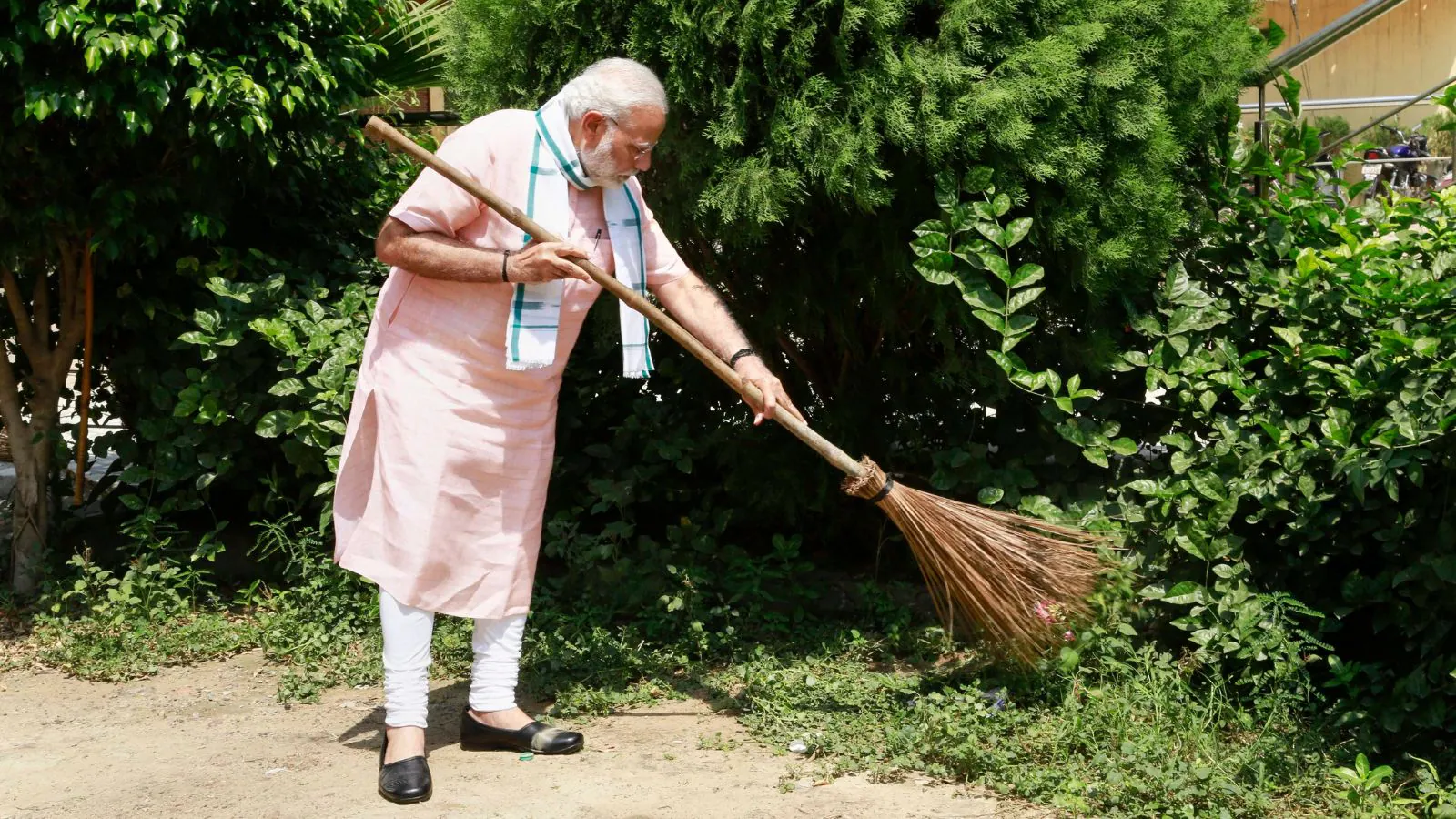By News18,Sohil Sinha
Copyright news18

It has been 11 years, and Prime Minister Narendra Modi’s Swachh Bharat Mission stands as one of the most successful examples of sustainable development implementation in modern history. Over a decade under its belt, this flagship programme has evolved from a sanitation initiative into a comprehensive sustainable development model that has redefined India’s approach to public health, environmental stewardship, and social transformation.
The Swachh Bharat Mission’s success stems from its meticulously crafted implementation framework, which addressed both infrastructure development and behavioural transformation. Launched on October 2, 2014, the mission aimed to eliminate open defecation by constructing over 12 crore household toilets, while simultaneously fostering a nationwide culture of cleanliness.
The mission’s dual-pronged strategy encompassed both rural and urban components, with SBM-Gramin focusing on rural sanitation coverage and SBM-Urban targeting comprehensive waste management in over 4,000 cities. It enabled coordinated action across diverse geographical and socio-economic contexts, ensuring that sustainable development principles were embedded at every level of implementation.
The government’s commitment to evidence-based planning is demonstrated through the substantial financial investment of Rs 1.40 lakh crore across both phases of the mission. It helped prioritise not merely toilet construction, but comprehensive sanitation infrastructure, including waste management systems, treatment plants, and recycling centres. The mission’s financial framework exemplified sustainable development principles by ensuring long-term viability rather than short-term fixes.
Community Mobilisation
The mission’s transformation from a government programme into a ‘Jan Andolan’ is its most significant achievement. Through intensive behaviour change communication campaigns, the mission reached rural Indians with an average of 50 messages per month over five years, funded by approximately $375 million. It leveraged traditional media, digital platforms, and interpersonal communication to create near-universal awareness and ownership of sanitation infrastructure.
Celebrity ambassadors, door-to-door outreach programmes, and strategic partnerships with diverse stakeholders, including community volunteers, school students, elected representatives, and industry leaders, formed the pillars of the behaviour change strategy. The mission’s success in activating all categories of citizens is proven by the participation of over 20 crore urban citizens across various platforms and activities.
The role of women as change agents proved particularly transformative. The mission empowered women not only as beneficiaries but as active participants in the construction and maintenance of sanitation infrastructure. UNICEF data reveals that 93 per cent of women reported feeling safer at home due to improved access to sanitation facilities, whilst the creation of a new generation of women masons demonstrates the mission’s success in generating livelihood opportunities for marginalised communities.
Quantifying Sustainable Impact
The health outcomes of Swachh Bharat Mission provide compelling evidence of its sustainable development impact. A study published in the Nature journal last year established that the mission prevents 60,000 to 70,000 infant deaths annually.
The World Health Organisation reports that between 2014 and 2019, the mission prevented 300,000 diarrhoeal deaths and districts with over 30 per cent toilet coverage experienced reductions of 5.3 points in infant mortality rate and 6.8 points in under-five mortality rate per thousand live births.
The mission’s impact on child nutrition is commendable. Studies comparing Open Defecation Free (ODF) and non-ODF areas reveal significant differences in health outcomes, with ODF areas showing a 9.3 per cent prevalence of diarrhoea compared to 13.9 per cent in non-ODF areas. Children in ODF areas demonstrated lower rates of wasting (21.7 per cent versus 34.3 per cent) and underweight conditions (28.3 per cent versus 41.2 per cent).
The mission’s contribution to educational outcomes, particularly for girls, is recognisable. The construction of separate toilet facilities for girls in schools increased from 37 per cent (0.4 million schools) to 91 per cent (nearly one million schools). It directly addressed barriers to girls’ education, with improved sanitation facilities contributing to reduced dropout rates and enhanced learning environments.
Environmental Sustainability and Circular Economy Integration
Under SBM-Urban, India now processes 81 per cent of generated urban solid waste, an increase from just 16 per cent in 2014. The processing capacity has reached 1,29,206.87 tonnes per day out of 1,59,109.02 tonnes generated daily, supported by an extensive network of Material Recovery Facilities, composting plants, and waste-to-energy infrastructure.
In addition, of 2,492 lakh tonnes of accumulated garbage, 1,437 lakh tonnes (58 per cent) have been remediated, reclaiming over 7,646 acres of land for productive use. The progress helped address the environmental degradation and also created opportunities for green cover development and urban regeneration.
The Modi government also had many parallel schemes running to the Swachh Bharat Abhiyan. The GobarDhan scheme helped propel the mission’s circular economy approach by converting organic waste into biogas, bio-CNG, and organic fertilisers. Implemented across 67.8 per cent of India’s districts, the scheme operates over 1,008 biogas plants that transform cattle dung and agricultural residue into valuable resources. It also led to a reduction in methane emissions, improved rural sanitation, and provided farmers with cost-effective alternatives to chemical fertilisers.
The Jal Shakti Abhiyan’s ‘Catch the Rain’ campaign, launched in March 2023, focuses on source sustainability for drinking water, complementing sanitation infrastructure with water security measures. This integrated approach ensures that sanitation improvements do not compromise water resources, embodying sustainable development principles.
Global Recognition and Knowledge Leadership
The international recognition of Swachh Bharat Mission underscores its significance as a global model for sustainable development. Prime Minister Modi’s receipt of the ‘Global Goalkeeper’ award from the Gates Foundation in 2019 acknowledged the mission’s global significance and innovative approach. The mission’s achievements have positioned India as a leader in the global fight against open defecation and poor sanitation.
India’s hosting of the 12th Regional 3R and Circular Economy Forum in Asia and the Pacific in Jaipur shows India’s lead in promoting circular economy principles globally. In addition, the World Economic Forum discussions at Davos 2025, featured India’s WASH innovations, and highlighted the mission’s role in driving global discourse on climate resilience and water sustainability.
Challenges and Continuous Evolution
Despite remarkable achievements, the mission faces ongoing challenges that provide insights for future sustainable development initiatives. Concerns regarding actual toilet utilisation and sustained behaviour change in some regions are prevalent. Acknowledging these challenges is crucial as they provide an opportunity to learn and adapt. Lessons from regions with lower utilisation rates underscore the need for tailored community engagement strategies. The mission’s response through Phase II implementation, focusing on ODF Plus status and comprehensive waste management, will be essential to stay on the path for sustainable development.
The allocation of resources between infrastructure development and behaviour change communication remains an area for continuous refinement. Critics note that only 3 per cent of the mission’s budget was allocated to behaviour change by 2021, suggesting potential for enhanced investment in social transformation components.
Swachh Bharat Mission’s 11-year journey is a clear example of how forward vision, on ground implementation, and adaptive management can transform sustainable development aspirations into outcomes. The infrastructure development, combined with community mobilisation and institutional innovation, has created a model to address complex development challenges. As India continues to refine and expand this approach through SBM 2.0, the mission’s legacy extends far beyond sanitation to encompass fundamental lessons about achieving sustainable development at scale.



